Former Chinese Nationalist Party (KMT) chairman Wu Poh-hsiung’s (吳伯雄) interpretation of the cross-strait status as “one country, two areas (一國兩區)” is in accordance with the Republic of China (ROC) Constitution, which states the ROC encompasses “Taiwan and mainland China,” Presidential Office spokesman Fan Chiang Tai-chi (范姜泰基) said yesterday.
During a meeting with Chinese President Hu Jintao (胡錦濤) on Thursday, Wu touted a “one country, two areas” concept to improve cross-strait ties. Wu’s remarks drew strong disapproval from the opposition.
The Presidential Office said the administration of President Ma Ying-jeou (馬英九) continues to handle cross-strait relations under the principle of “one China,” which is the ROC.
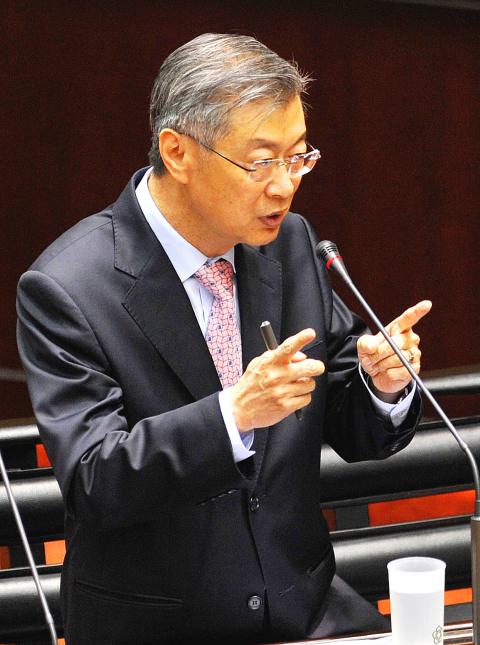
Photo: Chien Jung-fong, Taipei Times
Ma’s stance on defending Taiwan’s sovereignty using the so-called “1992 consensus” and the principle of “one China, with each side having its own interpretation” remains unchanged, Fan Chiang said.
“President Ma’s stance [on cross-strait relations] has never changed. In the Constitution, one China refers to the ROC, and the two areas refer to Taiwan and the mainland ... The mainland is the ROC’s territory outside of Taiwan and that definition was determined more than 20 years ago in a constitutional amendment,” Fan Chiang added.
Wu is leading a delegation to China to attend the annual forum between the KMT and the Chinese Communist Party (CCP) and it is believed that he was conveying the Ma administration’s cross-strait policy for the next four years to Hu on behalf of the president.
Following the Wu-Hu meeting, vice president-elect Wu Den-yih’s (吳敦義) upcoming visit to the Boao Forum in Hainan, China, from March 31 to April 3 is the next venue for cross-strait talks. Wu Den-yih is expected to meet Chinese Vice Premier Li Keqiang (李克強) at the forum.
Fan Chiang yesterday denied that Wu Poh-hsiung proposed the new definition on cross-strait ties with Ma’s approval, insisting that the definition has not changed.
“The sross-strait status is ‘one ROC, with two areas,’ and that definition has not changed throughout the terms of two former presidents and under President Ma,” he said.
Separately yesterday, Premier Sean Chen (陳冲) echoed the Presidential Office’s statement.
The “one country, two areas” formula is “in line with our understanding” based on Article 11 of the Additional Articles of the ROC Constitution, which is why the Act Governing Relations Between the Peoples of the Taiwan Area and the Mainland Area (台灣地區與大陸地區人民關係條例) was enacted, he said.
“Wu Poh-hsiung was repeating the spirit enshrined in the Constitution’s articles,” Chen said.
Chen did not answer when asked by reporters whether he accepted the “one country, two areas” formula; instead, he asked in return: “Is there any better way to describe the article in four words?”
Earlier yesterday, at the National Affairs Forum, during which lawmakers signed up for a three-minute speech in the legislature, Taiwan Solidarity Union (TSU) Legislator Lin Shih-chia (林世嘉) put an “X” over the character for “national” on the poster board and replaced it with the character for “area.”
“Following the ‘one country, two areas’ proposal, I feel so confused. Are we at the National or Area Affairs Forum?” Lin asked.
Ma did not deserve to be the country’s president, Lin said, adding that he may as well fly to China if he wants to be “area manager.”
Democratic Progressive Party (DPP) Legislator Wu Ping-jui (吳秉叡) said the “one country, two areas” proposal proves that it is a lie that China accepts Taiwan having its own interpretation of “one China,” as Ma has previously claimed.
If China allows Taiwan room to interpret “one China” in its own way, “why didn’t KMT officials mention that in China?” he asked.
TSU Legislator Hsu Chun-hsin (許忠信) said the KMT should expel Wu Poh-hsiung from the party for downgrading the country’s status because his “one country, two areas” proposal means that Taiwan is “one area” in the People’s Republic of China (PRC).
KMT Legislator Chen Chen-hsiang (陳鎮湘) denied the DPP’s and TSU’s allegations, saying that they had wrongly interpreted the meaning of “one country,” which he said was the ROC, rather than the PRC.
Later yesterday, during a question-and-answer session in the legislature, the premier agreed with DPP Legislator Lee Chun-yi (李俊俋) that the ROC is an independent, sovereign country, and so is the PRC.
Sean Chen disagreed that the situation amounts to two Chinas, “because there is no country in the world whose official name is ‘China,’” he said.
Lee asked the premier to make a formal declaration on the floor of the legislature that the ROC is an independent, sovereign country and not an area of the PRC.
Sean Chen refused.
“It depends on how you define ‘China.’ For example, the US says that ‘China’ is a civilization. There is no country in the world formally called ‘China,’” Sean Chen said.
In response to a question from DPP Legislator Chen Chi-mai (陳其邁) on whether Shanghai, Jiangsu Province and Taiwan belonged to the same country, Sean Chen said: “In our opinion, Shanghai is still a city that belongs to the ROC. It is just that it is not under the effective control of the ROC government.”
Chen Chi-mai said the reply was “the biggest joke in the world,” to which Sean Chen replied: “I know that it’s not easy to understand for foreigners, but that is what was stipulated in the Constitution.”
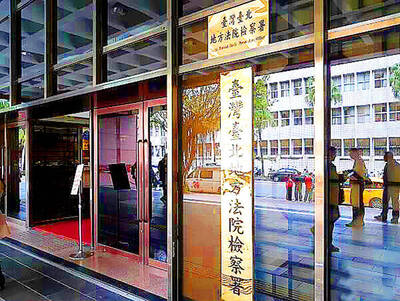
INVESTIGATION: The case is the latest instance of a DPP figure being implicated in an espionage network accused of allegedly leaking information to Chinese intelligence Democratic Progressive Party (DPP) member Ho Jen-chieh (何仁傑) was detained and held incommunicado yesterday on suspicion of spying for China during his tenure as assistant to then-minister of foreign affairs Joseph Wu (吳釗燮). The Taipei District Prosecutors’ Office said Ho was implicated during its investigation into alleged spying activities by former Presidential Office consultant Wu Shang-yu (吳尚雨). Prosecutors said there is reason to believe Ho breached the National Security Act (國家安全法) by leaking classified Ministry of Foreign Affairs information to Chinese intelligence. Following interrogation, prosecutors petitioned the Taipei District Court to detain Ho, citing concerns over potential collusion or tampering of evidence. The
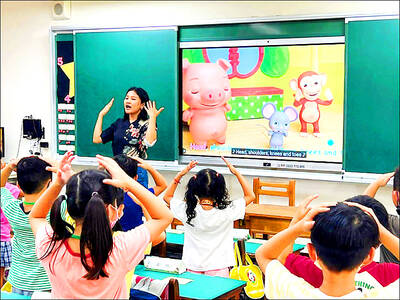
Seventy percent of middle and elementary schools now conduct English classes entirely in English, the Ministry of Education said, as it encourages schools nationwide to adopt this practice Minister of Education (MOE) Cheng Ying-yao (鄭英耀) is scheduled to present a report on the government’s bilingual education policy to the Legislative Yuan’s Education and Culture Committee today. The report would outline strategies aimed at expanding access to education, reducing regional disparities and improving talent cultivation. Implementation of bilingual education policies has varied across local governments, occasionally drawing public criticism. For example, some schools have required teachers of non-English subjects to pass English proficiency
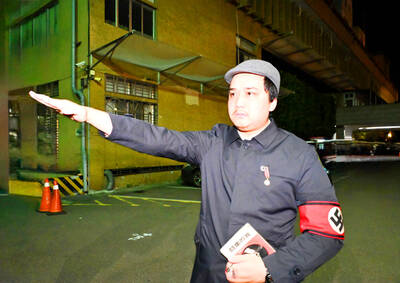
‘FORM OF PROTEST’: The German Institute Taipei said it was ‘shocked’ to see Nazi symbolism used in connection with political aims as it condemned the incident Sung Chien-liang (宋建樑), who led efforts to recall Democratic Progressive Party (DPP) Legislator Lee Kun-cheng (李坤城), was released on bail of NT$80,000 yesterday amid an outcry over a Nazi armband he wore to questioning the night before. Sung arrived at the New Taipei City District Prosecutors’ Office for questioning in a recall petition forgery case on Tuesday night wearing a red armband bearing a swastika, carrying a copy of Adolf Hitler’s Mein Kampf and giving a Nazi salute. Sung left the building at 1:15am without the armband and apparently covering the book with a coat. This is a serious international scandal and Chinese
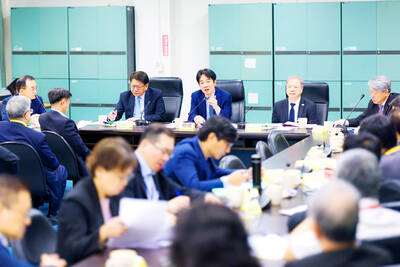
NEGOTIATIONS: The US response to the countermeasures and plans Taiwan presented has been positive, including boosting procurement and investment, the president said Taiwan is included in the first group for trade negotiations with the US, President William Lai (賴清德) said yesterday, as he seeks to shield Taiwanese exporters from a 32 percent tariff. In Washington, US Trade Representative Jamieson Greer said in an interview on Fox News on Thursday that he would speak to his Taiwanese and Israeli counterparts yesterday about tariffs after holding a long discussion with the Vietnamese earlier. US President Donald Trump on Wednesday postponed punishing levies on multiple trade partners, including Taiwan, for three months after trillions of US dollars were wiped off global markets. He has maintained a 10 percent